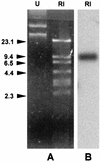IMP-12, a new plasmid-encoded metallo-beta-lactamase from a Pseudomonas putida clinical isolate
- PMID: 12709317
- PMCID: PMC153319
- DOI: 10.1128/AAC.47.5.1522-1528.2003
IMP-12, a new plasmid-encoded metallo-beta-lactamase from a Pseudomonas putida clinical isolate
Abstract
A Pseudomonas putida strain showing broad-spectrum resistance to beta-lactams, including expanded-spectrum cephalosporins and carbapenems, was isolated from a patient with a urinary tract infection at the University Hospital of Varese in northern Italy. The isolate was found to produce metallo-beta-lactamase activity and to harbor a 50-kb plasmid, named pVA758, carrying a new bla(IMP) determinant, named bla(IMP-12). Plasmid pVA758 was not self-transferable by conjugation to either Escherichia coli or Pseudomonas aeruginosa but could be introduced by electroporation and maintained in the latter host, where it conferred resistance or decreased susceptibility to various beta-lactams. The IMP-12 enzyme is quite divergent from other IMP variants: its closest relatives are IMP-8 and IMP-2 (89 and 88% sequence identity, respectively), and IMP-1 is 85% identical to IMP-12. The bla(IMP-12) determinant is carried on an integron-borne gene cassette whose attC recombination site is related to those present in cassettes containing bla(IMP-1), bla(IMP-6), bla(IMP-7), bla(IMP-10), and bla(IMP-11) and unrelated to that present in cassettes containing bla(IMP-2) and bla(IMP-8). IMP-12 was overproduced in E. coli by using a T7-based expression system and was purified by cation-exchange chromatography followed by gel filtration. Kinetic analysis revealed that, like other IMP variants, IMP-12 exhibits an overall preference for cephalosporins and carbapenems rather than for penicillins and does not hydrolyze temocillin and aztreonam. However, IMP-12 also exhibits some notable functional differences from other IMP variants, including uniformly poor activity toward penicillins (k(cat)/K(m) values, around 10(4) M(-1). s(-1)) and a remarkably high K(m) (around 900 micro M) for imipenem.
Figures



References
-
- Concha, N. O., C. A. Janson, P. Rowling, S. Pearson, C. A. Cheever, B. P. Clarke, C. Lewis, M. Galleni, J. M. Frere, D. J. Payne, J. H. Bateson, and S. S. Abdel-Meguid. 2000. Crystal structure of the IMP-1 metallo-β-lactamase from Pseudomonas aeruginosa and its complex with a mercaptocarboxylate inhibitor: binding determinants of a potent, broad-spectrum inhibitor. Biochemistry 39:4288-4298. - PubMed
-
- Da Silva, G. J., M. Correia, C. Vital, G. Ribeiro, J. C. Sousa, R. Leitão, L. Peixe, and A. Duarte. 2002. Molecular characterization of blaIMP-5, a new integron-borne metallo-β-lactamase from an Acinetobacter baumannii nosocomial isolate in Portugal. FEMS Microbiol. Lett. 215:33-39. - PubMed
-
- Farinha, M. A., and A. M. Kropinski. 1990. High efficiency electroporation of Pseudomonas aeruginosa using frozen cell suspensions. FEMS Microbiol. Lett. 70:221-226. - PubMed
Publication types
MeSH terms
Substances
LinkOut - more resources
Full Text Sources
Other Literature Sources
Miscellaneous

